
Rapido Trains Inc. has released an updated version of its highly detailed HO scale model of United Aircraft’s TurboTrain. The firm is calling this release TurboTrain 2.0. Much like the real high-speed train sets developed and built in the late 1960s and then upgraded through their service lives, Rapido’s own HO scale model of the iconic gas-turbine-powered train has seen many improvements since its first offering in 2008. Most notable among the TurboTrain’s upgrades are better operating and running characteristics. These include excellent slow-speed motor control and completely redesigned, free-rolling single-axle trucks between the cars. Rapido does point out that the new Turbo model is not compatible with its original 2008 equipment.
Trains of the Jet Age
The TurboTrain started life as the Turbine Motor Train (TMT) project, proposed by United Aircraft in 1965 to modernize passenger train travel. The idea was to take aviation technology, including gas-turbine-powered jet engines, and build lightweight high-speed passenger trains with it. The United States Department of Commerce signed on to the idea in 1966 for a two-year demonstration period, which would be extended once the trains entered service. Later that same year, the Canadian National (CN) ordered some as well.
United Aircraft built a total of seven train sets, two for the U.S. and five for CN, although some of the CN equipment eventually migrated to the States. The U.S. trains were built by Pullman-Standard in Chicago; the Canadian sets were fabricated by Montreal Locomotive Works. The original gas turbine ST-6B engines were supplied by Pratt & Whitney Canada.
The train sets were built using aluminum construction with low centers of gravity and used the Spanish Talgo design for single-axle trucks between the cars using 30” wheelsets. This provided a much smoother ride for passengers at high speeds and also helped to reduce train weight. The two Power Dome Cars (PDCs) in each train set each had a single dual-axle power truck. U.S. TurboTrains were also equipped with 600VDC third-rail pickup shoes for operation in and out of Grand Central and Penn Stations in New York. During a test run in 1967, a U.S. TurboTrain set the North American train speed record, topping out at 170.8 MPH. That record still stands.
The U.S. train sets operated between New York and Boston on the New York, New Haven & Hartford (later Penn Central) under contract with the U.S. Department of Transportation. Their Canadian counterparts ran mostly between Montreal and Toronto. The modern, comfortable trains were popular with travelers when introduced in late 1968 but suffered from a lot of growing pains. The CN trains required heavy upgrades to combat the cold Canadian winters. The entire fleet of TurboTrains also required a lot of expensive maintenance, often after every run. Poorly funded Amtrak ended its TurboTrain service in 1976, while the CN trains passed on to VIA Rail and lasted until October 1982.
Rapido’s prototypical train sets
Rapido has produced three different Power Dome Car (PDC) and six different Intermediate Car (IC) configurations to allow it to accurate reproduce the Turbo’s train sets in all of their significant paint schemes and car arrangements.
U.S. Department of Transportation trains were delivered as 3-unit sets, and Rapido offers those decorated in both the original United Aircraft gray-and-blue scheme and Penn Central/U.S. DOT colors. In 1972, the DOT expanded its TurboTrains to five cars by ordering two more Intermediate Cars and painted the trains for Amtrak. Rapido offers a five-car set in early Amtrak red/white/black (the one we tested), and one for late Amtrak red/white/blue. Amtrak later picked up an additional 4-car TurboTrain from CN, which can be depicted with the late Amtrak train by removing one coach.
The five Canadian National train sets started with seven cars each, but after a significant modification program, CN swapped equipment to create three nine-car trains. Rapido offers the basic CN train as a five-car set, as well as a four-car add-on set to build either a seven- or nine-car train. The nine-car trains were repainted in the yellow and blue VIA CN scheme in 1976 before becoming part of VIA Rail in 1978.
The model

We received a five-car early Amtrak set for review. The train consists of two PDCs (Nos. 28 and 29), two ICs (TurboCoaches Nos. 36 and 37), and one TurboCafe (No. 29). Note, the numbers refer to the car’s configuration and not to its road number. The decoration on the train is excellent, capturing the striking red/white/black early Amtrak paint scheme well. The PDCs include both the Amtrak arrow and Department of Transportation logo. The body shells feature many details, including separately applied windshield wipers.
The models include LED lighting inside and out, with gold-white headlights and roof-mounted interior lighting. The lighting circuit has a capacitor for flicker-free operation, and they provide even light throughout the train. There are dual headlights on each end, as well as a Gyralite (activated by function 3 on DCC). On the rear of the train, there is a red Gyralite. These lights automatically switch ends when changing directions. You can turn the interior lights off using the included magnetic wand.
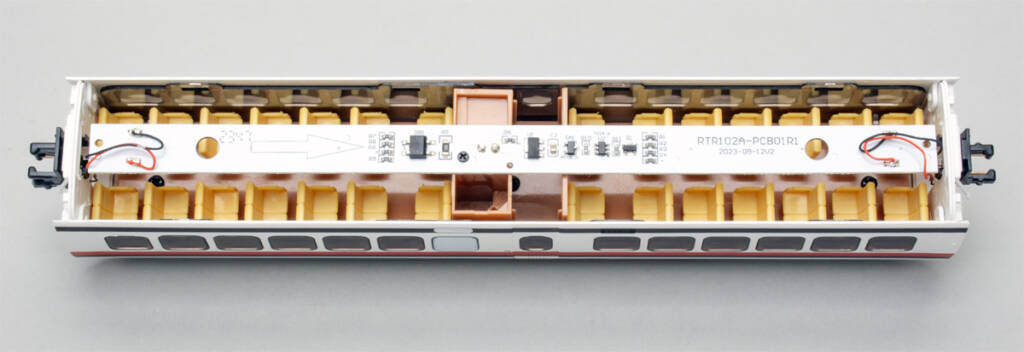
The intermediate coach roofs are removable, allowing the modeler to add figures to the detailed interiors. They are held in place by 8 press-fit tabs, four evenly spaced on each side of the carbody. Typical of Rapido Trains’ attention to detail, the various ICs and PDCs match their prototypes’ floorplans.
Since this is a Talgo-type train set, the cars share the single-axle intermediate trucks. Rapido has made assembling the train set as easy as possible. The undersides of the cars are marked with both position in the train and direction. Begin with the PDC marked No. 1, which has its intermediate truck already attached to it. Next, take the IC marked No. 2 and slip the Talgo truck’s stabilizing bars through the eyebolts on the IC. Working on a curve makes this task easier, as it allows you to insert one bar at a time. With the stabilizing bars in their support bolts, then clip the single-clip black coupler mounted to the back of the IC’s bulkhead to the metal support post on the truck and place the PDC and the IC on the track.
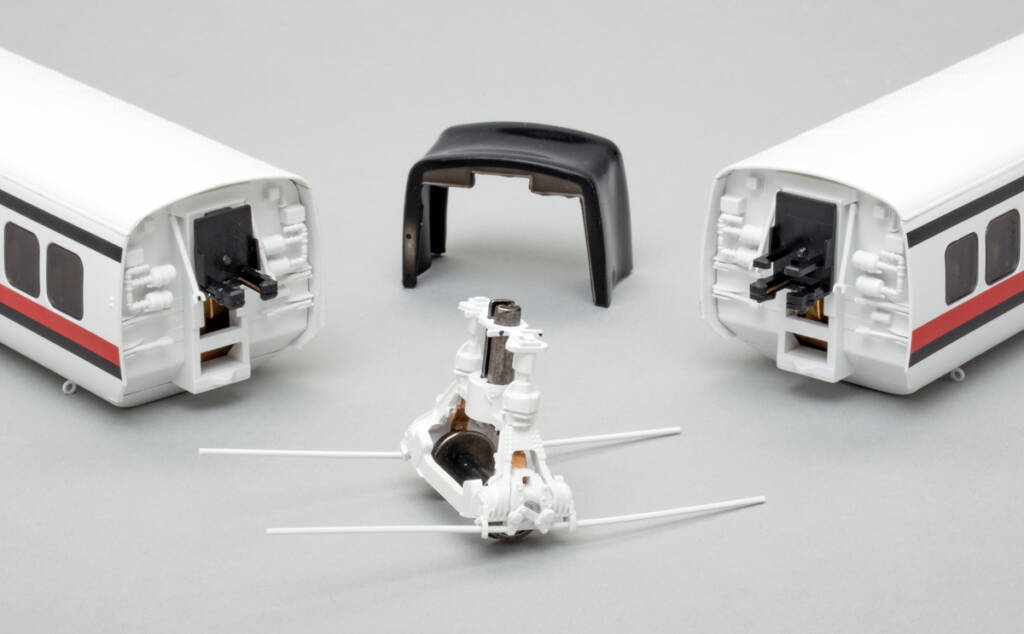
Note that the black car couplers have single and double clip versions. The single couple fits in between the double coupler all along the train, so you should never have a truck attached with two single couplers. The single-clip black coupler on our sample PDC No. 53 was slightly askew when we first attached it to the train, and it caused its connecting Talgo truck to derail on curves. After carefully straightening the PDC’s coupler, it operated correctly without issue. It is probably best to check that all of the couplers are aligned properly before assembling the train.
Select the next car in numerical sequence and add it to the train until all cars are connected. On the Canadian train sets, there are gaps in the numbering sequence in the five-car sets. Simply choose the next highest number and keep going. The four-car add-on sets have the additional cars necessary to complete nine-car trains and are numbered accordingly based upon their position.

Once connected, never attempt to pick up the entire train while it’s coupled together. Instead separate it into two-car sections before lifting it.
Next, insert the black diaphragms. These press-fit between the cars by carefully compressing them one at a time and slipping them between the car ends. The shell has a lip all the way around the end bulkheads, and the diaphragms rest just inside of it. Once it expands in the gap, it’s held in place by tension. Even with the diaphragms installed, the train will negotiate 18” radius curves (if you clip the guidance arms from the intermediate trucks), although it will look a lot better on 22” curves or larger (no arm clipping needed).
Sound and speed
The new TurboTrain features a motor in each PDC, plus an ESU LokSound decoder and speaker. A big improvement on the new model is its drive system. Using an NCE Power Cab DCC system set for 28 speed steps, our train crept along at 1.4 scale mph at speed step 1. Top speed at step 28 was 88 mph. Though below the normal 100 mph cruising speed of the TurboTrain, and well off from the record, it works well as a layout top speed — the train doesn’t look like it’s standing still and eats up the track quickly.
Perhaps the most notable thing was how smoothly the train operated all through the speed range. Our sample had no performance issues and glided along effortlessly through the 28” radius curves and No. 5 turnouts on our HO scale East Troy layout.
Our train came with normal driving wheels and carried its two PDCs and three ICs around the track well. Rapido also includes replacement driving wheels with traction tires, which weren’t necessary for our use, but may be helpful for those running full nine-car Canadian train sets.
The train includes a host of sounds, including some made from actual TurboTrain recordings. They are activated using DCC functions. The doppler horn was one of my favorites. Be aware that many of the sounds will only play when the function is first activated. For example, after activating F6 to play the “open doors” sequence, you will need to turn off F6 before being able to play that sequence again.
As delivered, the TurboTrain’s decoders are set for Canadian station announcements, which are found on functions 11 through 16. If you have an American TurboTrain, press F17 to switch to the train’s U.S. station announcements. These are found on functions 11 through 15.
Our sample came with the sound level set to the max. Though some of the sounds were OK at that level, many were just too loud. CV63 is the master volume control. By setting its value to 100, I was able to get a good general volume level for the full range of sounds. The sound decoders in the train must be programmed in tandem, so be sure both PDCs are on the track before doing any programming work to adjust volumes, train control, or even the road number.
You can also adjust the individual sound levels, but to do so, you must first program CV32 to a value of 1 before selecting the sound to adjust. CV32 is an index selection register CV, which allows the same CV numbers to be used for various decoder functions depending upon the register you select. If you don’t set CV32 to the proper register first, you will not be programming sound levels but likely something entirely different on the decoder. Be aware that this warning is printed on the back of the sound settings chart page. Even though it is in a big black warning box, it is easy to miss it. I only found it after I’d set the master volume.
And don’t be too worried if you do make a mistake with CV32 or some other programming aspect on the model. You can factory reset the model by programing CV8 to a value of 8.
An exciting model
Rapido has done an excellent job revamping one of its iconic models. As the story goes, Jason Shron started Rapido Trains Inc. just because he wanted an HO scale TurboTrain. I, for one, greatly appreciate the upgraded drive and operating characteristics and have really enjoyed running the train on various layouts.
Admittedly, the window for modeling this train is fairly small; 1968 to 1976 in the U.S. and to 1982 in Canada. Also, the running location for the trains was confined to just two regions of North America. However, keep in mind that if you model the late 1960s or 1970s, TurboTrains made goodwill tours in both the U.S. and Canada. If you model that era, you could conceivably run the TurboTrain as a special passenger move on your layout. For example, in 1971 the TurboTrain visited 31 states to promote the newly formed national passenger carrier, Amtrak.
As a final note, when I was in grade school, we were shown a United Aircraft Corp. promotional film about how it designed, tested, and built the TurboTrain. I’ve never forgotten it, and I was just as excited then about the new jet-age train as I am today with the Rapido’s upgraded model of it. Hopefully you will be, too, with version 2.0.
Facts & features
Price: Three-car set, $749.95; five-car set, $899.95; four-car Canadian add-on sets, $319.95; single coach, $89.95.
Manufacturer
Rapido Trains Inc.
382 High St.
Buffalo, NY 14204
rapidotrains.com
Era: 1967 to 1982 (varies based on paint scheme)
Road names: Amtrak early (1971-1973); Amtrak late (1973-1976); United Aircraft/Department of Transportation (1967-1969); Penn Central/U.S. DOT (1969-1971); Canadian National; VIA Rail Canada
Features
- Metal wheels on plastic drive axle gears, properly gauged
- Minimum radius, 18″ (with modification); recommended radius, 24″
- Weight: PDCs 11.0 ounces; ICs 2.7 ounces






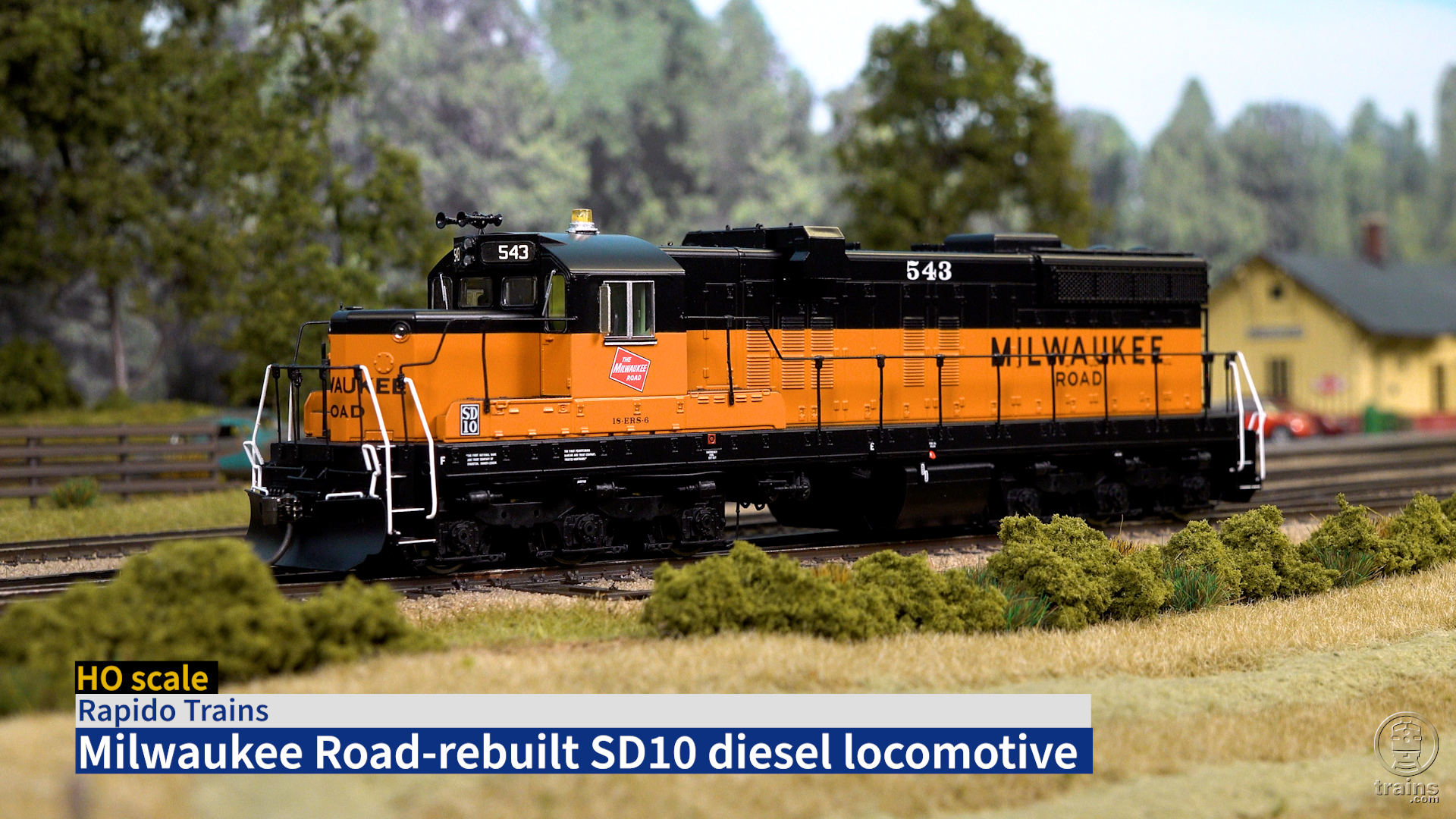

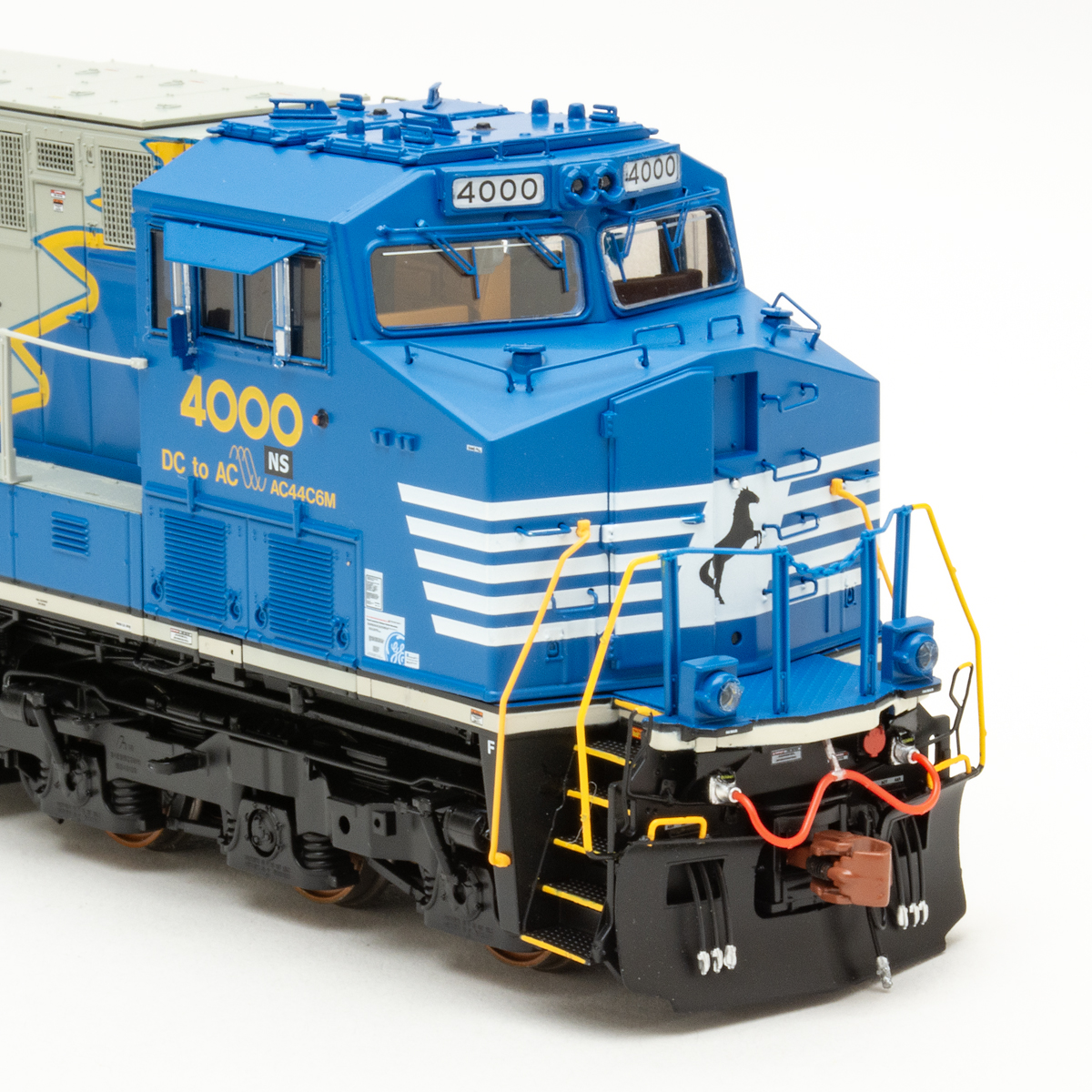
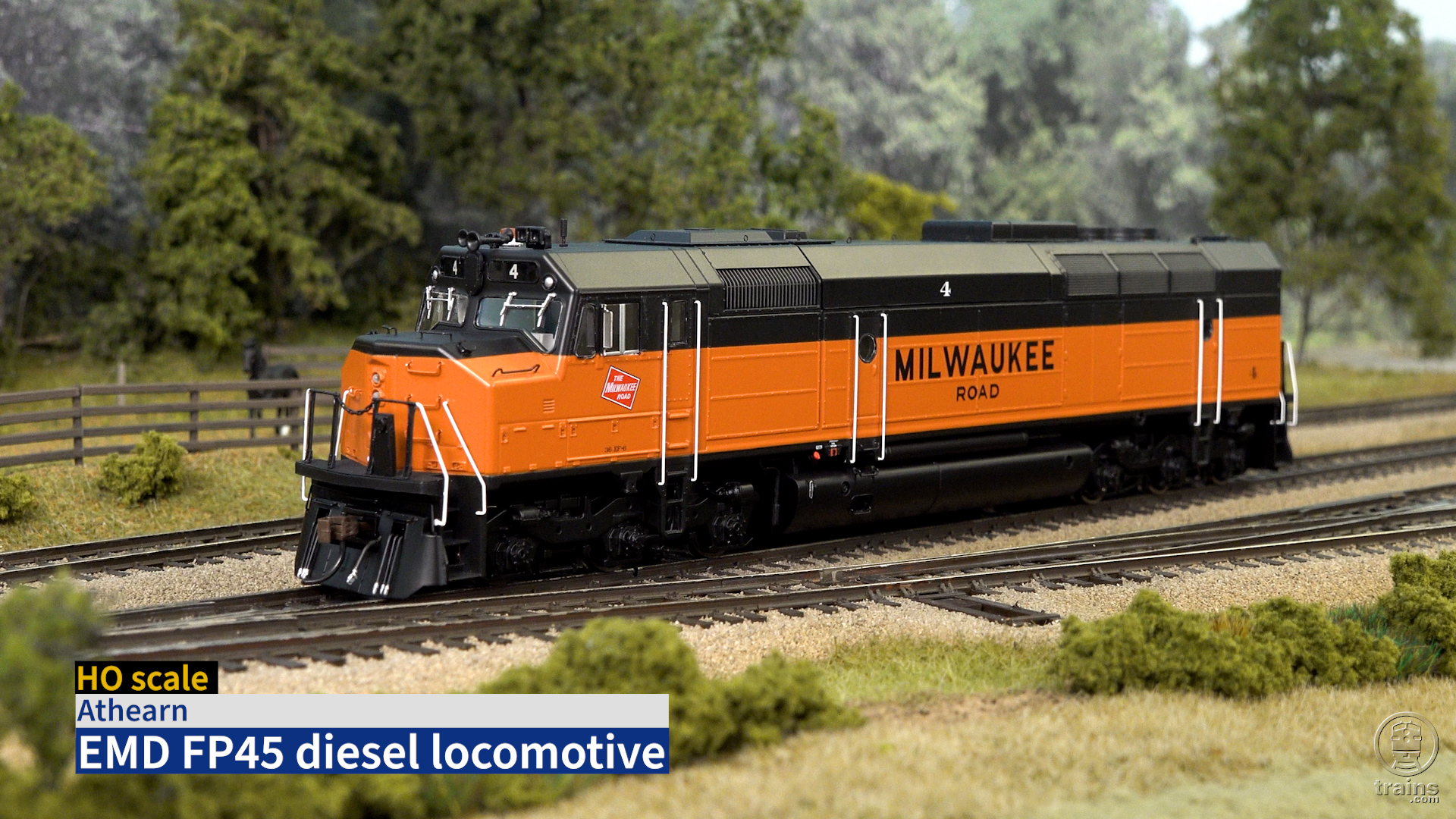

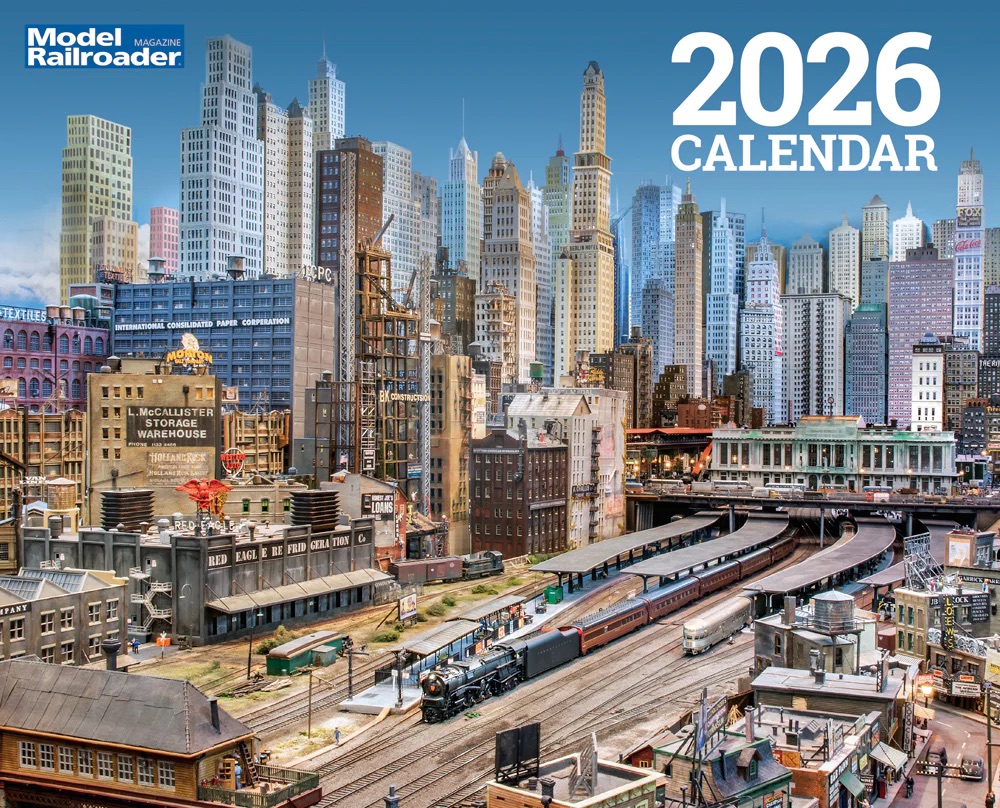
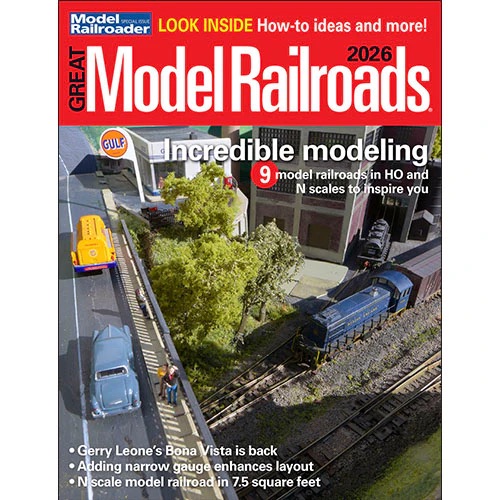
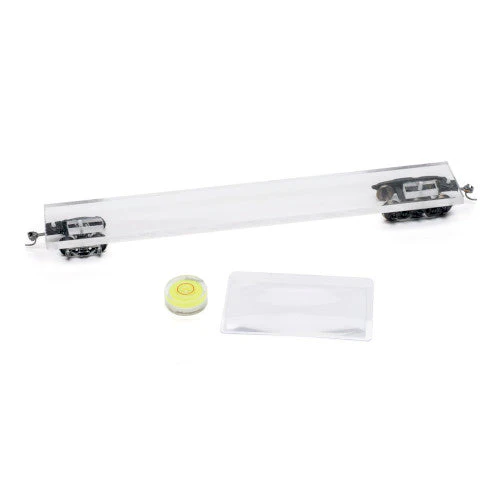
I rode the TurboTrain from Boston to NY back in 1970. I rode in the front PDC and found the ride very bouncy. Noisy, too, but that wasn’t a surprise. I’m glad I had the experience.